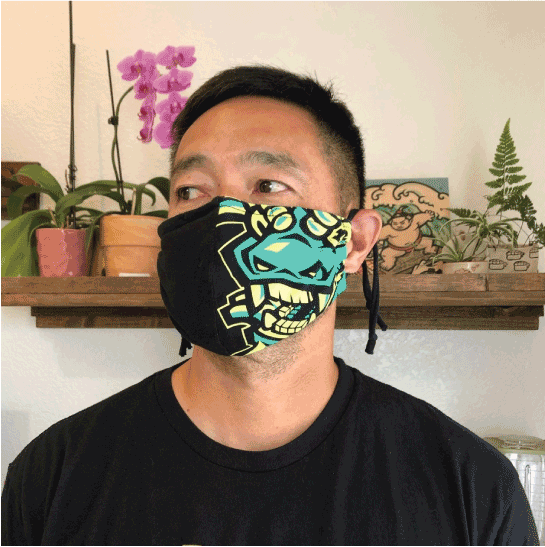This story is part of our new series “Mask Envy,” where we showcase San Franciscans’ creativity and take a look at some of the coolest masks spotted around the city. Have a look you want to submit? Email info@thebolditalic.com.
Sumofish artist and creator Brandt Fuse grew up in Hawaii, where he developed a love of the ocean. Later in life, a year spent in Japan fueled an appreciation for his heritage. He took those two passions—the water and all things Japanese—as inspiration to create Bay Area–based T-shirt brand Sumofish, which he runs with his wife, Joni.
Fuse spent summers working at Grant Kagimoto’s Cane Haul Road, one of Hawaii’s iconic T-shirt brands. At the time, he didn’t know how much that would influence him later in life. Fuse moved to San Francisco in 1998, where he waited tables in Japantown and worked at Kurt Osaki Design, eventually launching Sumofish three years later.
With his partner, Fuse “created a line of unique characters that combined his love of Japanese culture and memories of fishing back in the islands.” They launched the brand at the Nihonmachi Street Fair in SF Japantown in 2002. Since then, they’ve traveled the country to sell T-shirts at fairs.
Sign up for The Bold Italic newsletter to get the best of the Bay Area in your inbox every week.
Once the pandemic hit, those fairs were called off, and the husband-and-wife duo found a way to supplement their income: selling masks online.
We caught up with Fuse to ask him about his company and mask-making.
TBI: Hi! Fill us in on your company.
Brandt Fuse:
We started Sumofish in the Bay Area in 2002. We’re a small business, run by me and my wife, Joni Fuse. I’m a graphic artist, and I created a line of designs influenced by my Japanese American background/culture and Hawaii upbringing. We sold these designs on T-shirts and decals at festivals and fairs around the country, as well as online and through a few boutiques.
Why did you decide to make masks?
When the pandemic hit, our main source of income—those festivals and fairs — were canceled, and we became an entirely online brand. We needed to quickly figure out how to make up for the loss of our face-to-face selling and attract more customers to our website. Joni has a background in fashion design, so making masks offered a solution.
How do you make the masks?
When Joni initially started making masks, materials such as elastic, fabric, and thread were hard to come by, but we had a warehouse full of T-shirts… Using our family and friends as guinea pigs, Joni came up with a mask pattern that used only our T-shirt material, including the body and adjustable straps. It’s a simple design focused on making the masks user-friendly and, most of all, comfortable. The masks feature our most popular T-shirt styles, and our customers were very supportive.
Which is your favorite mask and why?
Our favorite mask is the Shisa Koi mask. The Shisa is an Okinawan guardian lion-dog, which is symbolic of the protection masks offer the public.
How can we purchase one of your masks?
They’re available at Sumofish.net.








